-
 With So Many Options Available, It can Be Difficult to Choose the Right Laptop: Here's Our Curated List of Best Laptops for Gaming in 2020
With So Many Options Available, It can Be Difficult to Choose the Right Laptop: Here's Our Curated List of Best Laptops for Gaming in 2020
-
 Want to Be the King of Battle Royale? Try These 8 PUBG like Games in 2019 + 5 Bonus Games for Smartphone Gamers!
Want to Be the King of Battle Royale? Try These 8 PUBG like Games in 2019 + 5 Bonus Games for Smartphone Gamers!
-
 Are You One of Those Who Trains with or without Gloves in the Gym? And Looking for Best Gym Gloves! 10 Best Gym Gloves in India That Will Make Your Workouts More Comfortable 2020
Are You One of Those Who Trains with or without Gloves in the Gym? And Looking for Best Gym Gloves! 10 Best Gym Gloves in India That Will Make Your Workouts More Comfortable 2020
Cultural History of Traditional Indian Board Games
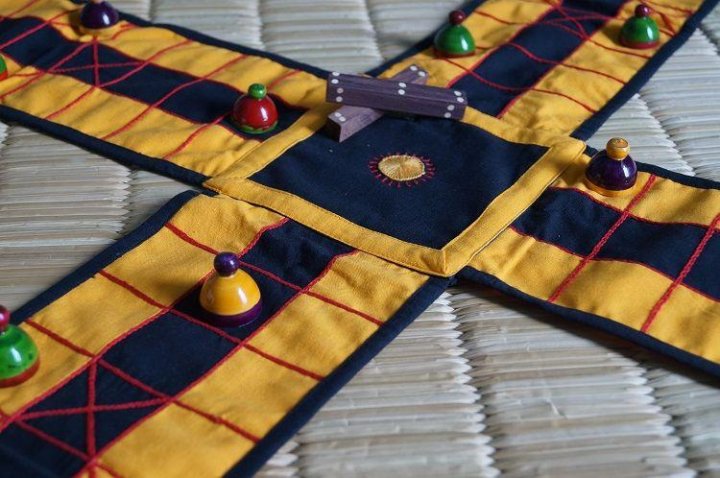
Early evidence of board games was found in the form of archaeological finds from the Indus Valley civilization. During the Vedic Period, gambling through board games was a popular activity. In fact, there are several hymns in the Rig Veda that confirm the same. After a close study of this period, scholars found that there were square-shaped pieces and cowry shells to play the game instead of cubic dice. This progressed into more sophisticated versions of board games; for example, Pachisi was a popular board game played by kings and queens. Emperor Akbar actually had a Pachisi court built in Fatehpur Sikri where real people were used to play instead of the game pieces. Post this, board games became very popular all over the country and the world.
8 Fun Traditional Indian Board Games
1. Pachisi
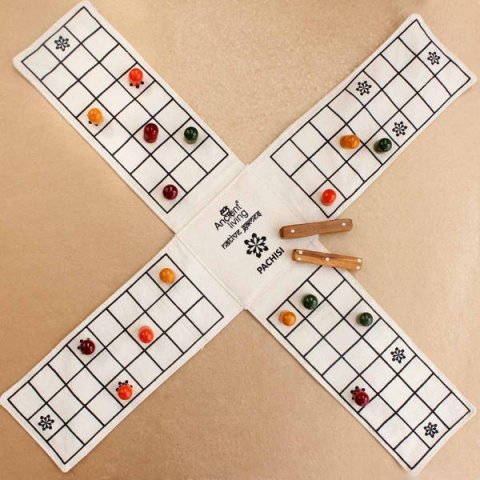
Pachisi is one of the oldest and traditional board games in India. It has been played for ages by everyone from a normal subject to the kings and queens. This game gained more popularity and was at its peak during the Mughal Period. Emperor Akbar built a giant board in Pachisi Courtyard in the Fatehpur Sikri Fort and turned this indoor into an outdoor game. He also had women from his harem moving around as pawns instead of the game pieces.
This is the source of the popular board game we know today – 'Ludo', which was reintroduced in India by the British. This game has many variations, unlike other board games all over the country such as Chaupad, Pagade, Dayakattam, Aksha Kreeda, and Chokkattan, etc.
The game board is a symmetrical cross with six or seven cowrie shells as dice and indicates the number of spaces to move forward. The word 'pachis' means twenty-five in Hindi, which is the highest score thrown by the cowrie shells. Hence, the name 'Pachisi' was derived. This game requires a minimum of two players and a maximum of four players to play. There are two teams, one with red and green pieces and the other with yellow and black pieces. The first team to reach the finish box with all the designed pieces wins the game. The board game is available on Qtrove for Rs. 950.
2. Dash Guti Game

Dash Guti is one of the traditional Indian board games, belonging to the Indian War-games category along with the other games like Egara-Guti, Lau Kata Kati, Pretwa, and Gol-skuish. One of the most important aspects of these games is the use of strategy to win. The common thing among these board games is that all the pieces are laid out in the grid pattern board with only one vacant box in the middle. This leads to capture the other player's piece by making the initial move to the middlebox.
This abstract strategy board game is a two-player game, which is similar to Draughts and Alquerque. There is a common vertex to which two triangles are connected. Each player sits at the opposite sides and starts at the base of each triangle. The center point of the board is the common vertex. The game pieces are of two colours, white and black. Each player chooses one colour and then captures the pieces of the other player as the game progresses. The pieces that are captured are removed from the game. At the end of the game, the player with more pieces wins. The board game is available on Amazon for Rs. 700.
3. Snakes and Ladders (Moksha Patam)
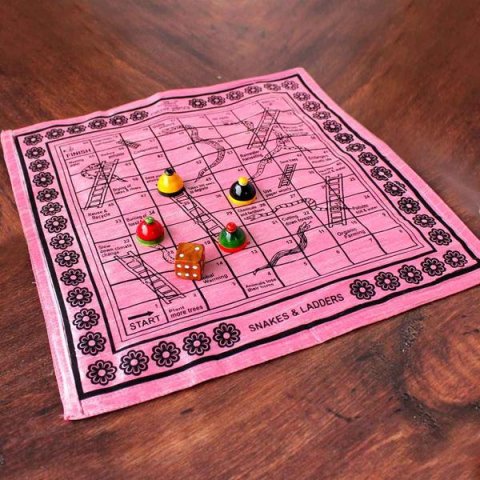
Moksha Patam is an ancient dice board game of India, which also goes by Gyan Chauper, Parama Padam, and is popularly known as Snakes and Ladders game. It is a game of pure luck as there is only one pawn with each player and the dice decides the fate of the game. It originated in India but later became quite popular across the world. The main purpose of the game is not just entertainment, but also the morality of it. It conveys the concept of liberation from the bondage of passion and the movement from lower levels of consciousness to the higher levels of spiritual enlightenment and, in the end, to Moksha. So one can say it is a roller coaster ride for the players.
The game was believed to be the symbolic attempt to reach God. The snakes represent vices, and ladders represent virtues. It is a two-player game, and the game progresses by rolling the dice in turns, which decides the number of spaces to move. The first player to reach the finish box wins the game. This traditional board game is available on Qtrove. Crafted in raw silk, the price of this game is Rs. 1,329.
4. Navakankari
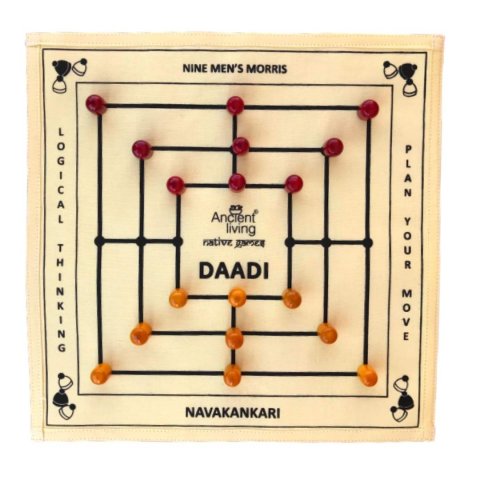
Navakankari is an ancient traditional Indian board game that is all about strategy, reasoning, planning, and decision making. It is quite popular in the western world and goes by Nine Men's Morris or Mills's. The meaning of the word 'Navakankari' is nine pebbles in Sanskrit. This board game is known by multiple names in different parts of India. In Karnataka, it is called Saalu Mane Ata, Char par, and Jodpi Aata. In Gujarat, it is called Navkakri, and in Andhra Pradesh, it is called Daadi.
The Navakankari board game consists of three concentric squares, with each of them being connected to the other squares through lines that connect the inner square's side with the outer square side in the middle. This creates a total of twenty-four spots to place the pieces on. It is a two-player game where both the players get nine pieces each of different colour. The player progresses by moving the pieces on the points where the two lines intersect or meet. The player wins when he/she blocks all the paths for the opponent to move or by reducing the number of opponent's pieces to two. Available on Amazon, the price of this board game is Rs. 700.
5. Pallankuzhi (Alu Guli Mane)
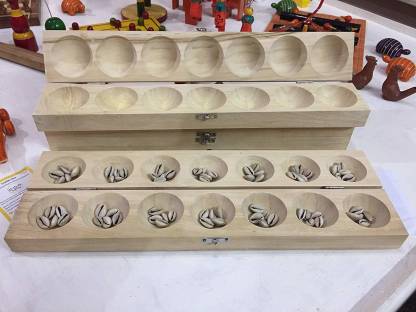
Pallankuzhi is an Indian board game that was introduced during the period of the Chola Dynasty. There are tales suggesting that people used to play this board game outside temples in Tamil Nadu, and it gained a lot of popularity after that. This game is known as Kuzhipara in Kerala and is the oldest form of the Mancala game. Ala Guli Mane, A cup, Coin game, Olinda Kaluja, Saat Kooti, Vamanaguntalu, Chenne Mane, and Kutki Boia are some of its other names.
The board game consists of elongated wooden boards, which have small carvings in them to form fourteen cups. It is hand-carved, and it involves counting and distribution of pieces in these cups. This game is a two-player game, and a player wins when he/she captures the opposite player's pieces. The board game is available on Flipkart for Rs. 399.
6. Chowka Bhara
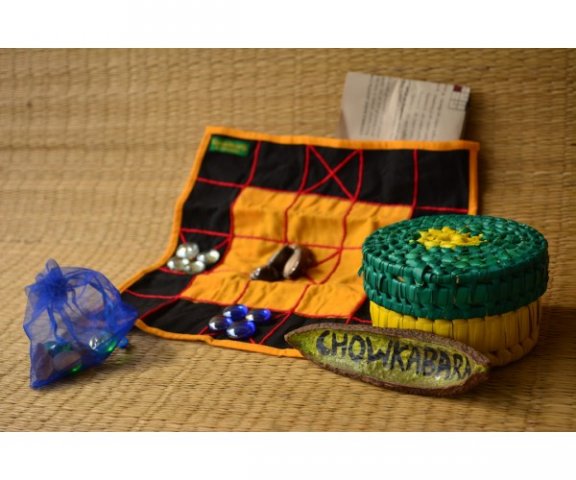
Chowka Bhara is one of the oldest and traditional games in India. It originated in the Vedic period and played the most important role in Mahabharata. The Pandavas and Kauravas play the game where Pandavas loses their kingdom and wife on a gamble. This game is famous throughout the country with different names. In Maharashtra, it is Challas Aath, in Madhya Pradesh, it is Kavidi Kali, and in Punjab, it is Khaddi Khadda. Eight and Four, Aada Sada, Kattam Kazhi, Ettu Veedu, Kattam Kali, and Changapoo are other names.
The game is played by a minimum of two players and a maximum of four players in two teams. Each team has four to six pieces of distinct colours. It is a game of luck and also a mindful strategy. The roll of dice decides the number of spaces to move, and the team that manages to get all their pieces in the innermost box of the board wins the game. The players are also allowed to knock off the pieces of other teams to win. It is a game of strategy and planning. This game is very similar to Ludo and has similar rules as Ludo. The embroidered Chowka Bara board game is available on unfactory.in for Rs. 875.
7. Chaturanga
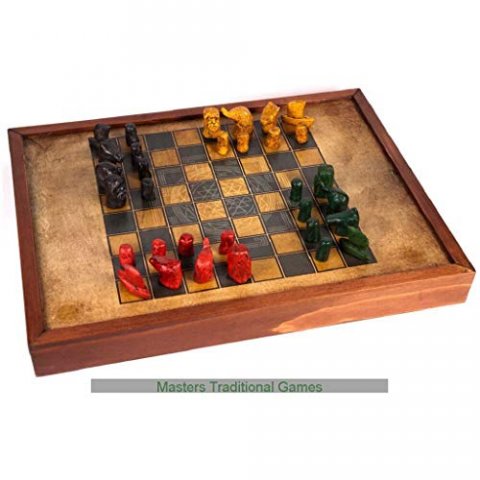
Chaturanga is a Sanskrit word, which means 'four parts' and was first seen in Mahabharata and Ramayana. It is one of the ancient aristocratic games of India. It started in the Gurukulas around the sixth CE in order to teach the young princes about the segments of the royal army, which are the cavalry, the elephants, the chariot, and the infantry. The modern version of the game is now one of the most popular board games known as 'Chess'. Originally, this game was invented in India, which was later discovered by the West Asians who then introduced it to Europe, where it got its name 'Chess'.
Chaturanga is played on a board with eight by eight squares summing up to sixty-four squares that are uniformly coloured with black and white. It is a two-player game where each player chooses one colour. Each player has 16 pieces in a total of one colour: 1 raja, 1 vizier, 2 elephants, 2 chariots, 8 pawns and 2 horses. The player with white pieces must start the game. A player must use the strength and pattern of movements of each of these pieces and strategize accordingly. A player wins when he/she has captured the king by blocking any possible move. You can purchase this Chaturanga set from Desert Cart.
8. Aadu Puli Aatam
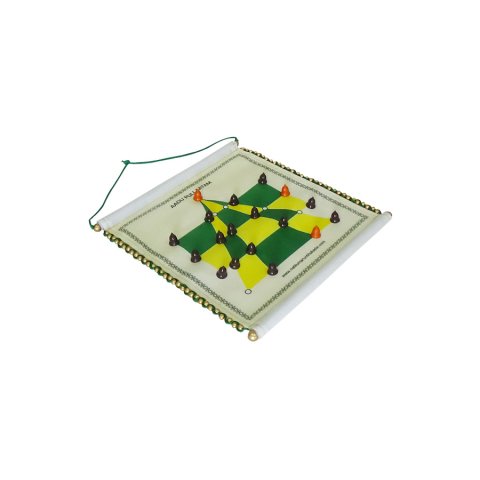
Aadu Puli Aatam is a traditional Indian Board game that was inspired by hunting practices. This game also goes by the names Puli Meka, Astha Chamma, Vamana Guntalu, Ancient living, The Tiger and The Goat, Adu-Huli Aata, and Bagh Aur Bakri in different parts of India. This is the game of planning, skill, and strategy development. This game signifies a hunt in the jungle and the importance of survival.
This is a game of two players where one player controls three tigers and the other controls fifteen goats. The game requires careful planning and focus. Here, the goats try to corner the tiger in order to immobilize them while the tigers try to eat them. The aim is to determine whether the goats' strategy in defeating the tigers or will the tiger kill the goats and prove that he has superiority over the jungle. Available on touchmytown.com, price of the board game is Rs. 331.
4 Apps to Play Your Favourite Traditional Board Games
1. Snakes and Ladders
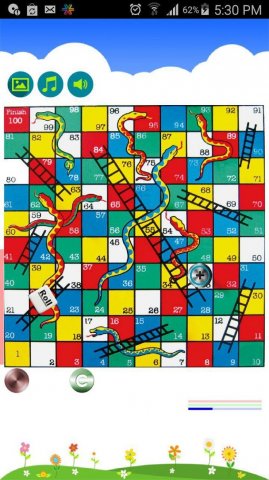
This is a fun game to play. We all have used the physical version of this game, but now you can enjoy the mobile phone game through the 'Snakes and Ladders' app. It is the same as the actual game, with all the rules being precisely the same. The app is designed well with a user-friendly interface.
2. Indian Ludo

Ludo is everyone's favorite; enjoy this game now on the smartphone. It is available both on the Play Store and App Store. The app allows the user to play with a computer or along with friends.
3. Ludo/Pachisi/Chaupar
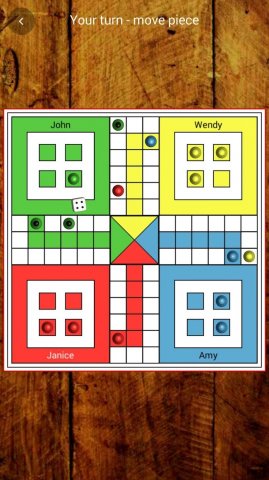
Pachisi is the traditional Indian board game that was played by Emperor Akbar himself. This app has Pachisi, Chaupar, and Ludo, a perfect blend of one app's best board games. Now play this board game at any time, anywhere on the smartphone.
4. Mankala
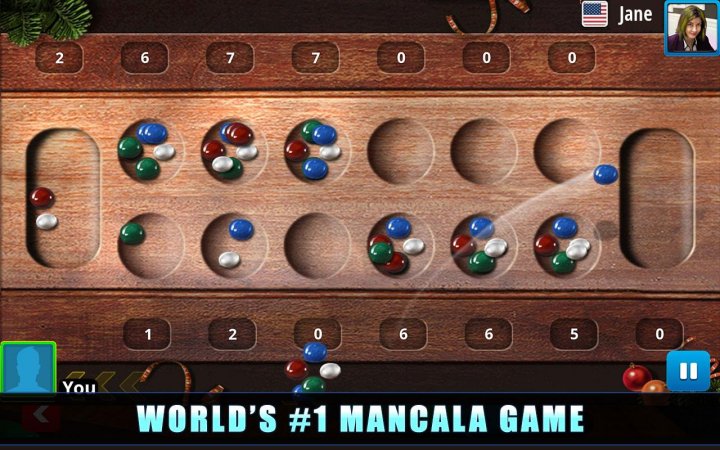
Mankala is a board game that is not easy to find these days, so the best way to still get access to it and enjoy playing it is through the 'Mankala' app. The app is compatible with both Android and iOS. It has clear instructions on how to play the game that helps the user all through.
Benefits of Playing Board Games

Board Games are not only entertaining, but it brings people together through cooperative and competitive gameplay. Here are the top benefits of playing board games.
- Family Time – Spending quality time with family is drastically reduced these days due to the different schedules of each family member. Playing board games is a fun way to get together, maybe after dinner, which will also strengthen the family bond.
- Improves Cognitive Skills and Memory Formation – Prefrontal Cortex and Hippocampus is the part of the brain that is associated with complex thoughts and memory formation. Playing board games will be benefitted immensely. Engaging in board games will also improve essential cognitive skills such as problem-solving, decision-making, and strategic thinking.
- Reduces Anxiety – You are in a joyful mood while playing board games. This is vital to have a good time that generally reduces stress. Playing board games is also one of the enjoyable ways to increase creativity and learning experience.
- Therapeutic – Fine motor skills are used to play most of the board games like picking and moving the pieces. This action involves agility and coordination. These skills are helpful in occupational therapy treatments.
- Improves Immune System – Negative thoughts and stress can reduce the body's ability to fight disease. The laughter and enjoyment that one gets while playing board games prevents the harmful effects of chemicals released by the body.
-
 Sweaty Hands or Moving on to Much Heavier Weights? Gym Gloves Can Help Make Your Workout Smoother: 10 Gym Glove Sets Carefully Chosen to Suit Your Sport & Gym Needs (2020)
Sweaty Hands or Moving on to Much Heavier Weights? Gym Gloves Can Help Make Your Workout Smoother: 10 Gym Glove Sets Carefully Chosen to Suit Your Sport & Gym Needs (2020)
-
 यह साल निस्संदेह लड़ाई वाले खेलो का वर्ष है(2019):10 PUBG शैली जैसे खेल जिन्हें आप खेल के आजमा सकते हैं।
यह साल निस्संदेह लड़ाई वाले खेलो का वर्ष है(2019):10 PUBG शैली जैसे खेल जिन्हें आप खेल के आजमा सकते हैं।
-
 Are You a Gamer at Heart? Here are the Top 10 Games for Android You Cannot Miss in 2019
Are You a Gamer at Heart? Here are the Top 10 Games for Android You Cannot Miss in 2019
-
 If You Love to Play Video Games, Purchasing Xbox 360 Games Could Elevate Your Gaming Experience to an Apex Level(2021)! Xbox 360 Games You Cannot Miss.
If You Love to Play Video Games, Purchasing Xbox 360 Games Could Elevate Your Gaming Experience to an Apex Level(2021)! Xbox 360 Games You Cannot Miss.
-
 अगर आप भी ऑनलाइन गेम्स के शौकीन है, तो इन 10 बेहतरीन ऑनलाइन गेम्स पर अपनी नजर जरूर डालें । साथ में ऑनलाइन गेमिंग से जुड़ी कुछ जरूरी बातें (2019)
अगर आप भी ऑनलाइन गेम्स के शौकीन है, तो इन 10 बेहतरीन ऑनलाइन गेम्स पर अपनी नजर जरूर डालें । साथ में ऑनलाइन गेमिंग से जुड़ी कुछ जरूरी बातें (2019)
Make Your Own Board Game!
This may sound like a huge task to do, but if you're someone who likes puzzles and board games, this is one idea you will absolutely love! Search around how these games were originally made, and you can definitely make your own modifications to them. And even if you're not feeling up for it, you can add your own rules to the games to make them more fun and interesting.

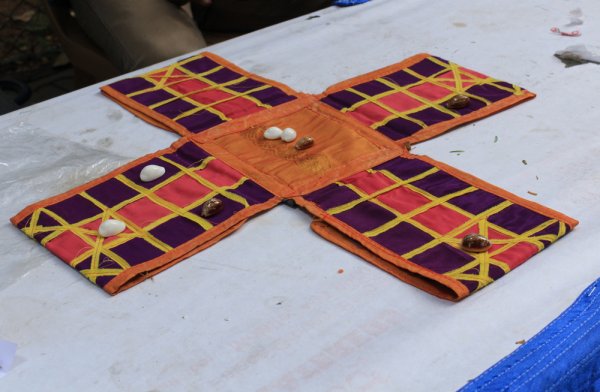
 Highlight the Best Facets of Your Incomparable Beauty: Discover the Best Face Highlighter Currently Available in India and Everything You Need to Know About Using Face Highlighters for Maximum Effect (2023)
Highlight the Best Facets of Your Incomparable Beauty: Discover the Best Face Highlighter Currently Available in India and Everything You Need to Know About Using Face Highlighters for Maximum Effect (2023)
 Forget the Blemishes and Get that Picture Perfect Flawless Radiance on Your Face: Check out the Best Foundations for Oily Skin Currently Available in India and Everything You Need to Know About Makeup Foundations (2023)
Forget the Blemishes and Get that Picture Perfect Flawless Radiance on Your Face: Check out the Best Foundations for Oily Skin Currently Available in India and Everything You Need to Know About Makeup Foundations (2023)
 Make Your Presence Felt Wherever You Go: Discover the Best Perfumes Under 2000 for Both Men and Women to Announce Your Arrival and Make Any Occasion Memorable (2023)
Make Your Presence Felt Wherever You Go: Discover the Best Perfumes Under 2000 for Both Men and Women to Announce Your Arrival and Make Any Occasion Memorable (2023)
 Protect Your Oily Skin from the Harmful Rays of the Sun: Discover the Best Gel Based Sunscreens for Oily Skin and Everything You Need to Know Before Buying One (2023)
Protect Your Oily Skin from the Harmful Rays of the Sun: Discover the Best Gel Based Sunscreens for Oily Skin and Everything You Need to Know Before Buying One (2023)
 Minor Blemishes and Wrinkles Affecting Your Confidence? Check out the Best BB Creams to Conceal Your Worries and Nourish Your Skin to Restore the Healthy, Radiant and Glowing Complexion Back Again (2023)
Minor Blemishes and Wrinkles Affecting Your Confidence? Check out the Best BB Creams to Conceal Your Worries and Nourish Your Skin to Restore the Healthy, Radiant and Glowing Complexion Back Again (2023)
